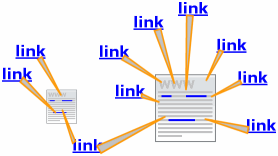
Like many others have mentioned, I often associate hypertexts with Wikipedia. One of my favorite ways to waste time is getting into Wikiholes, starting with one innocent article and then it’s suddenly been three hours following different links. I’ve ended up on the Titanic passenger list too many times to count.
I think that hypertexts definitely change the way we read texts, although its harder to recognize the way this impacts us having grown up with hypertexts in digital texts because this generation is so used to it and has had this all their lives. While we have always been reading printed texts, we’ve had access to this technology for most of our lives and its expected to be there for us. In Reading on Screen: The New Media Sphere, Christian Vanderdorpe discusses how hypertext “showed its
ultimate strength in its ability to link seamlessly billions of pages as if they were a single entity, a constantly evolving book” (Vanderdorpe). I do think that there could be hypertexts in a very loose sense of the word in text that isn’t digital. Much like we find interesting links in a Wikipedia article, we find topics that interest us in traditional text that we decide to do more research on. This type of hypertext, of course, it less immediate and less accessible than hypertext in a digital text.
Hypertexts allow us to quickly get new information, but I could also see this as a bad thing. Because we’re so used to seeing and following hypertexts, it might impact how long we focus on and pay attention to a reading. There are a lot of articles that show ways digital reading may affect how long we’re able to read online for, so hypertexts could definitely be playing into this. Even reading an article for academic purpose and not just for fun, it’s easy to get distracted by all the content available to us. I would consider this as more of a side affect, rather than an negative thing, as essay access to information is a very valuable thing to have.
Word Count: 349
Vandendorpe, Christian. “Reading on Screen: The New Media Sphere.” Companion to Digital Literary Studies, https://drive.google.com/file/d/1EZP8fDx4S_5gfAJ6L8Kv1f3jyAdKdqU_/view.